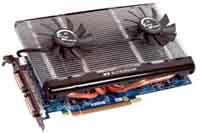Hi A1,
Don't worry if you have a Dell, HP or any other pre-assembled PC. I have a Dell

It's a 2004 Dell Dimension 8300 (see my sig) and it will outperform more than a few forum members' PC. However it came pre-assembled with a Radeon 9800 Pro back then as PCIe wasn't avaiable. I upgraded the graphics card last September to a
Gainward Bliss 7800 GS+ 512 and the hard diskdrive with a
150 GB Western Digital Raptor (the 10.000 RPM one).
To my knowledge the Gainward Bliss was the fastest AGP card available in September and I believe it still is today. The Raptor is still the fastest hard drive available now although they also have an 'X' version. I haven't figured out any difference between the two, besides the original Raptor being designated as an 'Enterprise Drive' and the 'X' version as a 'Desktop Drive'.
Last March I upgraded my rig with 2 x 1 GB sticks, which are paired, meaning exactly the same sticks, with the same amount of RAM running at the same speed. Paired sticks are 'better' than unmatched ones as unmatched sticks can vary in speed. The fastest stick will run at the speed of the lesser one if you don't have them matched. I didn't have matched sticks before that so my memory was not running to it's potential ...
But let's focus on your issue instead of me bragging about my specs. The point I'm making is that you still can upgrade a pre-assembled PC. Overclocking is just a little harder (if not impossible) with such a machine.
What you should do to check if you PC has an AGP or PCIe slot is open up the case. The slots should be located right below you processor. See if you have a free slot directly below your CPU. You can see the difference in slots
here. If you don't have either one you're basically stuck with your on-board card. The only way to solve this is replacing the motherboard, but that's very tricky with an OEM (pre-assembled PC). An AGP or PCIe slot is part of the motherboard and you can't replace an AGP card with a PCIe card like you can replace a sound- or a network card.
The difference between AGP and PCIe is that the latter has twice the bandwith of the first meaning that PCIe transfers date twice as fast as AGP, but still AGP is very fast. If you'd like to read a little more about AGP and PCIe check out Wikipedia
here and
here.
Hope this helps.
(if anyone likes to correct me on the statements above please do so

)












 I need to get a better one. Oh and I think Pac Man is still fun.
I need to get a better one. Oh and I think Pac Man is still fun. 












 Intel i7 960 quad 3.2G LGA 1366, Asus P6X58D Premium, 750W Corsair, 6 gig 1600 DDR3, Spinpoint 1TB 720
Intel i7 960 quad 3.2G LGA 1366, Asus P6X58D Premium, 750W Corsair, 6 gig 1600 DDR3, Spinpoint 1TB 720


 Mainboard: Asus P5K-Premium, CPU=Intel E6850 @ x8x450fsb 3.6ghz, RAM: 4gb PC8500 Team Dark, Video: NV8800GT, HDD: 2x1Tb Samsung F3 RAID-0 + 1Tb F3, PSU: Antec 550 Basiq, OS: Win7x64, Display: 24&
Mainboard: Asus P5K-Premium, CPU=Intel E6850 @ x8x450fsb 3.6ghz, RAM: 4gb PC8500 Team Dark, Video: NV8800GT, HDD: 2x1Tb Samsung F3 RAID-0 + 1Tb F3, PSU: Antec 550 Basiq, OS: Win7x64, Display: 24&



 )
)
 Mainboard: Asus P5K-Premium, CPU=Intel E6850 @ x8x450fsb 3.6ghz, RAM: 4gb PC8500 Team Dark, Video: NV8800GT, HDD: 2x1Tb Samsung F3 RAID-0 + 1Tb F3, PSU: Antec 550 Basiq, OS: Win7x64, Display: 24&
Mainboard: Asus P5K-Premium, CPU=Intel E6850 @ x8x450fsb 3.6ghz, RAM: 4gb PC8500 Team Dark, Video: NV8800GT, HDD: 2x1Tb Samsung F3 RAID-0 + 1Tb F3, PSU: Antec 550 Basiq, OS: Win7x64, Display: 24&
